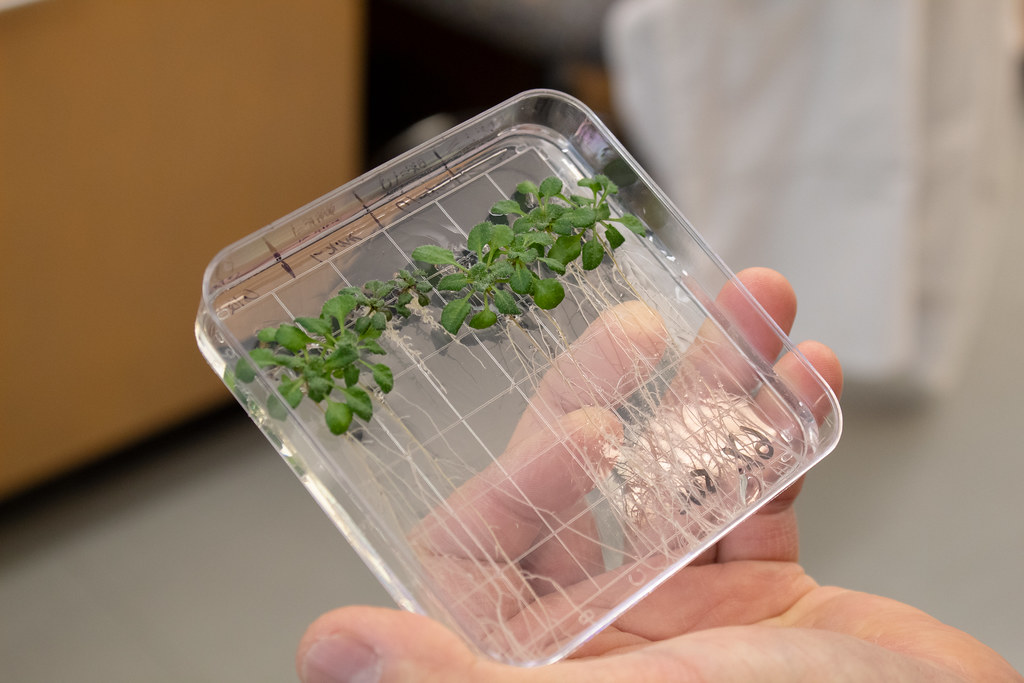
By Karly Balslew | Bond LSC
When we get hurt, our body signals our brain to warn us about stress and damage. We acknowledge the damage and then initiate the proper steps to heal.
Plants may have different receptors that read these stress signals, but the process is similar.
“When someone crushes the plant tissue, this triggers their immune system like us,” said Sung-Hwan Cho a researcher in the Gary Stacey lab at Bond Life Sciences Center. “Our focus is how the plant responds to their stresses, especially wounding.”
In plants, Adenosine triphosphate (ATP) plays a crucial role in regulating this process.
Cho explains that this signal is especially important because unlike humans, plants cannot move away from their stressors so they must adapt. Therefore, signals travel down a certain pathway to ensure the plant reacts appropriately to the damage. But without ATP, the process is lost.
As part of the Stacey lab, Cho recently published a recent paper in Nature Communications that detailed a key metabolite pathway in the ATP plant signaling process.
“What’s exciting about the mevalonate pathway is that the pathway is involved in producing so many molecules that are critical for plant growth and development,” said Bond LSC principal investigator Gary Stacey. “Such as a variety of different hormones and various lipids that are required. It means that purinergic signaling has a profound effect on plant physiology.”
Purinergic signaling is named after the purine compounds that are found in ATP. This signal is important as it helps researchers understand how plants handle external factors from their surrounding environment.
Purinergic signaling underpins a multibillion-dollar pharmaceutical industry for humans and animals. Hence, the hope is that, just as in these cases, further exploration of purinergic in plants will lead to practical means to alleviate stress in plants, improving plant health and, ultimately, yield.
Stacey explains that mevalonate kinase (MVK) is one of the first enzymes in the mevalonate pathway and impacts the metabolites, or functioning, of the plant.
Just like in humans, plants have metabolic functions that keeps the organism alive. When we eat food, our body breaks the food down into an energy form that the body can utilize. Plants do the same. These metabolite compounds are synthesized by plants and used for essential functions like growth and development. This process gets turned on or off by ATP.
ATP is predominantly the energy molecule of the cell. All the food that we eat eventually turns into ATP and provides us energy to function.
“You can think about it [ATP] as money. You can’t go to the store and do anything without money so the cell can’t do anything without ATP,” principal investigator Gary Stacey said.
When the body experiences stress, ATP is transported outside of the cell and acts as a signal to the rest of the body. However, when this idea was proposed in the 1970s, it was highly controversial, and many rejected the notion entirely explains Stacey. Since ATP is crucial to human and plant functioning, the idea that ATP was traveling out of the cell as a signal was ridiculed.
However, in the early 1990s, researchers identified the first receptors in humans that utilized this extracellular ATP. Researchers knew how important ATP is to the cell and realized how effective the molecule signal was. This is called purinergic signaling because it is triggered by nitrogen-based DNA building blocks named purines and compounds like ATP.
“If the cells make a receptor that’s recognizing extracellular ATP, then there must be extracellular ATP and it must act as a signal,” Stacey said.
Researchers turned to humans and studied their stress signals and the receptors.
However, the ATP receptors that were found in humans were not seen in plants. Researchers knew plants carried out these purinergic signals because plants reacted similarly to humans, but the receptor was unknown.
“Basically, what we do is we take the plant and then we screen for mutants that don’t recognize ATP. If the plant has a mutation in the receptor, then the plant will no longer recognize ATP. Once we identify the mutation, we can map the mutation and eventually identify the receptor,” Stacey said.
Stacey’s lab identified the first receptor, P2K1, back in 2014 through a genetic screening. Now the lab discovered another new receptor, P2K2. However, researchers also discovered that the enzyme mevalonate kinase (MVK) acts as a crucial component in the ATP signaling process.
“ATP can bind to the P2K1 and then the P2K1 interacts with the MVK. The MVK is then phosphorylated and activated to regulate diverse metabolites,” said researcher Daewon Kim, another author on the paper in the Stacey lab.
Yet even with new receptor and pathway discovery, more science is needed to fully understand this important signaling process. This research will move them closer to that understanding.
“Purinergic signaling is not just some side product but is really affecting a major pathway that is central to the way in which plants grow and develop,” Stacey said.
Read more about this work in the paper “Activation of the Plant Mevalonate Pathway by Extracellular ATP” published in January 2022 in the journal Nature Communications.
Sung-Hwan Cho is a Bond Life Sciences Center research scientist. Daewon Kim is a Bond Life Sciences Center research scientist. Gary Stacey is a curator’s professor of plant sciences and a Bond Life Sciences Center principal investigator.

